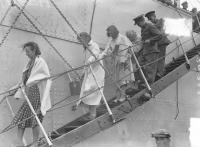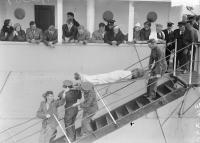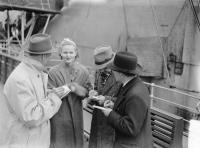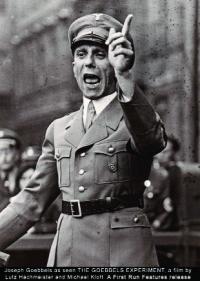‘The first casualty of the sea’: the Athenia survivors and the Galway relief effort, September 1939
Published in 20th-century / Contemporary History, Features, Issue 1 (Jan/Feb 2011), The Emergency, Volume 19
Some of the rescued Athenia passengers disembarking at Galway from the Norwegian freighter Knute Nelson, which picked up 430 of the survivers. (NLI)
The passenger liner Athenia sailed from Glasgow on 1 September 1939, picked up more passengers off Belfast later that day, and departed from Liverpool at about 4am the next morning (2 September), bound for Quebec City and Montreal in Canada. War was declared by the British government at 11am on Sunday 3 September, by which time the Athenia was only about 250 miles north-west of Inishtrahull Island, off County Donegal. German submarines, however, were already on the prowl around Britain and Ireland. At approximately 7.35pm, just as the sun was setting, Oberleutnant Fritz-Julius Lemp, commanding the U-30, fired two torpedoes at the approaching Athenia, one of which struck the ship near the engine room on the port side. Although the watertight doors were closed immediately, they only slowed the incoming water; the ship was dealt a mortal blow and began settling by the stern. For Western Europe and for Ireland, this was the dramatic beginning of the Second World War.
Rescue accomplished
Fortunately, all of the Athenia’s 26 lifeboats were launched, albeit two with some difficulty and loss of life. Although there were periodic squalls, the weather was relatively mild, with seas of four to six feet, growing to something closer to eight to ten feet by morning. Distress signals were picked up by a number of vessels in the vicinity and within a matter of hours a rescue was accomplished. One thousand, three hundred and six passengers and crew were saved, although 112 were lost. The stricken Athenia finally sank at about 11am on Monday 4 September. One of the rescue ships was the Norwegian freighter Knute Nelson, which picked up 430 survivors. Under orders from her owners to bring the survivors into a neutral port, the Knute Nelson steered south for Galway, Ireland having declared neutrality on 2 September.
The Knute Nelson radioed to the harbour master, Captain T. Tierney, that they were making for Galway with hundreds of refugees. Captain Tierney quickly informed all the local authorities to be prepared to deal with disaster relief. A committee was formed on Monday evening, including Galway mayor Joseph F. Costello and the Catholic bishop of Galway Dr Michael Browne. The committee alerted Galway County Council, the Board of Health, the Central Hospital, local hotels and the local bus company. The mayoress, Mrs Costello, also organised a committee of 38 local women to lead the volunteers, including the Girl Guides, who would be essential in looking after the specific needs of the refugees. The Irish cabinet met in Dublin late on Monday and made £500 available to the mayor to provide food, clothing and medical care to the survivors. Instructions were also sent to units of the Irish Army and An Garda Síochána to cooperate with local authorities in providing care and facilities, and the local schools were to be made available to house people. Seán T. O’Kelly, acting for the minister for

Soldiers of the 1st Infantry (Irish-Speaking) Battalion carrying one of the ten seriously injured stretcher cases off the Knute Nelson. (NLI)Soldiers of the 1st Infantry (Irish-Speaking) Battalion carrying one of the ten seriously injured stretcher cases off the Knute Nelson. (NLI)
education, made available the Preparatory College at Taylor’s Hill, Coláiste Éinde, to be used for refugees, as well as Galway Grammar School. The Irish Red Cross also started a subscription to raise money to assist the relief effort.
Shortly before midnight on Monday a pilot boat went out to Black Head to meet the Knute Nelson and steer the ship into Galway roads to anchor. Some time in the middle of the night a tender from Galway, Cathair Na Gaillimhe, under Captain William Goggin, anchored in the roadstead to wait for the freighter. The tender carried a local priest, Fr Conway, Dr S. Ó Beirne and Dr R. Sandys, and below decks were a number of nurses. Units of the 1st Infantry (Irish-Speaking) Battalion were on board to carry the stretcher cases off the ship, and members of An Garda Síochána were standing by. While it was still dark, a launch took out to the tender several more doctors, some journalists, Mayor Costello, Army Commandant Pádraig Ó Duinnín, Garda Chief Superintendent T. Ó Coileáin, and US minister to Ireland John C. Cudahy, who had come into Galway overnight. Dawn broke on a cold, raw day, with low clouds and white caps on the water, as the freighter slowly made its way to the roadstead, dropping anchor off Galway just after 10am on Tuesday 5 September.

The local press interview a surviver. (NLI)
‘As we went alongside the Knute Nelson a tremendous cheer went up from the survivors who lined the decks’, wrote the Connacht Tribune correspondent, Seán Kenny. ‘Many of them broke down completely and wept openly’, and more touching scenes were to come. Minister Cudahy was the first up the ladder to greet the survivors and to confer with Captain James Cook of the Athenia, but he was followed closely by Fr Conway and the doctors. Under the direction of the doctors, the Irish soldiers brought the stretcher cases and injured onto the tender first. Ten seriously injured stretcher cases were removed from the ship; among them were several elderly people, two Athenia crewmen who had been badly hurt in the explosion, and three children. Then the walking survivors made their way

Nazi propaganda minister Joseph Goebbels denied that the Germans had sunk the ship and claimed that the newly appointed British first lord of the Admiralty, Winston Churchill, had arranged to sink the Athenia in order to bring the United States into the war.
down the stairway, many only partially clad or
wrapped in blankets, and some wearing makeshift footgear made of gunny sacks and bits of cloth. A number of survivors suffered from broken bones, burns and bruises. Many people seemed still in a state of shock, particularly the children, who were crying or calling for their parents. Even so, when asked how she was doing, one young woman called down blithely from the Knute Nelson to a reporter on the tender, ‘I have lost everything except my sense of humour’. Most survivors expressed their gratitude toward Captain Carl J. Andersson and his crew. When all the survivors were on board the tender and the Knute Nelson began to weigh anchor to return to sea, one of them called out, ‘Three cheers for the captain of the Knute Nelson’, which was followed by still another shouting, ‘Three cheers for his crew’. Grateful farewells were said to the Norwegian crew who had worked to provide as much comfort as possible to the survivors.
When the tender came into Galway at about noon, hundreds of people lined the quay and gave a heartfelt cheer to the survivors themselves. But many observers were shocked and brought to tears at the sight of the distressed survivors, dressed in their borrowed sweaters and dungarees or cloaked in blankets. They were a bedraggled lot, and the children were most pathetic. The Gardaí assisted people off the tender, the injured first. White-uniformed nurses from the Galway Central Hospital and the army medical corps waited on the pier to assist all those with injuries. Once ashore, each person was given a hot cup of Bovril, good Irish bread and butter, and tea. Each of the survivors registered with the authorities, both for purposes of entry and to sort out the tangle of who was saved and who was lost. The Gardaí assisted people through this registration process. A witness to all of this, Seán Kenny, declared, ‘It was a sight that will imprint itself on my memory for all time’. Eventually, people were taken by bus to the Royal Hotel, where the survivors were given something more to eat and were directed to other hotels, homes and facilities where they could stay for the next several days. Toilet articles—combs, toothbrushes, shaving equipment—were provided, and in many instances new clothing was given. Galway, then quite a small city, opened its doors to the survivors. ‘The people of Galway have the greatest sympathy for these victims of the first casualty of the sea’, said Bishop Browne, ‘and are anxious to give them the Christian reception which should be afforded to human beings in such circumstances.’ Countless stories were told of shopkeepers refusing to take money for goods, not to mention the offer of free drinks for any survivor who made it to a pub.
On Saturday 9 September, arrangements were made by the steamship company for most of the Athenia survivors to take the train from Galway to Dublin, and then from Dublin to Belfast and Larne, where they boarded the ferry to the Scottish port of Stranraer and a return to Glasgow. Some of the Athenia people were still in hospital and some had dispersed out of Galway to stay with friends or family in Ireland, while some had left Galway for London. By the end of the week most of the very grateful survivors had left. Eventually, most of the survivors made it across the Atlantic, the Americans on a relief ship, the Orizaba, and the Canadians on Canadian Pacific Line steamers.
Secretary of State Cordell Hull sent instructions to the American legation in Dublin on Thursday 7 September to say to the Irish government that the United States ‘is deeply appreciative of the hospitable assistance given to the American survivors of the S.S. Athenia by the authorities and people of Éire’. The Galway Observer published Minister Cudahy’s generous statement: ‘I cannot praise too highly the efficient handling of the situation by the Galway people and the Irish government and their splendid human spirit’. The Irish taoiseach, Eamon de Valera, sent notes to both Bishop Browne and Mayor Costello informing them of his pleasure at the remarks of the American minister and of American gratitude, and extending his own thanks on behalf of the Irish government for their good work. The Canadian high commissioner in London also sent thanks to the Irish government: ‘The government of Canada is deeply appreciative of this generous action, and wishes to extend to the government and people of Ireland their sincere gratitude’. Both the people of Galway and the government had responded quickly and generously. Despite Ireland’s neutrality, the Second World War had come to Galway. HI
Francis M. Carroll is Professor Emeritus at St John’s College, University of Manitoba.
Further reading:
F.M. Carroll, ‘The first shot was the last straw: the sinking of the T.S.S. Athenia in September 1939 and British naval policy in the Second World War’, Diplomacy and Statecraft 20 (3) (September 2009), 403–13.
M. Caulfield, Night of terror: the story of the Athenia affair (London, 1958).
M. Caulfield, Tomorrow never came: the story of the S.S. Athenia (New York, 1959).
C. Rademacher, Drei Tage im September: Die letzte Fahrt der Athenia 1939 (Hamburg, 2009).
















